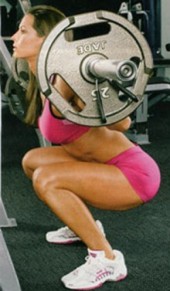Some Thoughts on Periodization
August 10, 2010 by danny · 7 Comments
The scary P word. I’ve known many people that would prefer to spend the entire day at the dentist rather than talk (or think about) periodization. Most people just want to go lift and turn their brain off for one hour, 3 to 4 days out of the week. To a certain point, I can see why this is the mind-set of many trainees. After all, you don’t have to look very hard to hear one trainer make a particular suggestion (no matter what the topic – reps, sets, form, tempo, etc), only to read 5 other trainers give 5 different opinions. Well, I’m here to help simplify.
I’m not going to get into a 12-month periodization plan that involves in-season, early off-season, general off-season, and pre-season planning. If you train athletes and are looking for a great resource, check out Eric Cressey’s, “The Ultimate Off-Season Training Manual.” This is a must for your coaching library!
For the purposes of this post however, I’m not going to be giving my thoughts on periodization for athletes (although some of this information can be useful if you are an athlete or train athletes). I’ll be speaking more to the trainee just looking to improve his or her health and physique.
-For the most part, you don’t need to plan more than a month in advance. Don’t get me wrong, I do think it is smart to look down the road for more than a month at what you are looking to accomplish. For example, I don’t recommend doing three straight blocks focusing on hypertrophy, then move on to a fat loss phase for a month, only to go right back into a hypertrophy phase. Just randomly throwing a fat loss block in there doesn’t really fit, and probably would hurt your chances to maximally put on muscle. But the bottom line, don’t sit on your butt for a month straight trying to figure out the perfect macrocycle when you could have been in the gym getting closer to your goals during that time.
-Psychology/motivation is huge! Yeah, full body (FB) training is great for fat loss. But let’s say that you just spent your last two training blocks (8 weeks total) training FB and you CAN’T STAND the thought of going into another FB block. After all, it can be very draining to know that you are going to be doing a deadlift or squat variation AT EVERY SINGLE session, EVERY SINGLE week. Even if a body part split may be less than perfect for fat loss purposes, it can be very motivating to know you are about to head to the gym, and NOT have to squat or deadlift. “Today’s back and biceps? Sweet, I can’t get to the gym soon enough!” Be sure to keep this in mind as you head into your next training block (or a block sometime down the line).
-I’ve tried just about every combination of fluctuating volume over the course of a training block (4 weeks). I’ve tried the Cressey Performance way (at least this is the way they typically set up a block the last time I checked), which is;
- Week 1 – High Volume
- Week 2 – Medium Volume
- Week 3 – Very High Volume
- Week 4 – Low Volume (Deload)
Then, there is a the Results Fitness way (again, last time I checked);
- Intro Week
- Base Week
- Overload Week
- Shock Week
Coach Alwyn Cosgrove sets it up so each week is harder than the next. Essentially, you build up each week so by the last week you are hitting your highest loads of the block and maybe setting some PR’s in the process. Then the next week you will start a new block, with the lowest volume (basically, your deload week).
There are other ways to set up this week-by-week fluctuation in volume/intensity. But right now, here is what I have been doing for some time now…
- Week 1 – Intro Week; Volume is lower than week 2 and 3 and I stay a little further from failure on this week. Basically, when bar speed is slower than rep 1, I stop the set. This isn’t set in stone, as I’m not really too scared about overtraining if I am doing some curls. So if I “grind” out a few reps on certain exercises, I’m cool with it. But I doubt you’ll see me doing multiple sets to failure with front squats, for example.
- Week 2 – Volume goes up and I may have a few more of the “grindy” reps than on week one. Still, I never go ’til I purposefully miss a rep
- Week 3 -Similar to week 2
- Week 4 – Deload week; volume is similar to week 1, maybe even a little lower (for the females, check out this article that I wrote awhile back – something to think about)
Justification
When I was doing the Cressey Performance set-up, I personally didn’t like to go into a high volume week when starting a new block. In week one of a new block, you are switching up exercises, sets, and reps. This greatly increases the chances of soreness. And then add to the fact that it is high volume week, I found this to be a recipe to have me limping around for days (especially on exercises that tend to make us sore anyway. i.e. RDLs). This is why I have since switched to week 1 being a low(er) volume week. I figure, I am going to be sore anyway on week 1, why make it even worse.
The Results Fitness way is great, but here I found I didn’t like the psychological aspect real well. By the time week 4 of the same program roles around, I’m actually getting a little bored. The last thing I want to do is make this my hardest week. A slight mental break, by going low(er) volume, is nice here. Plus, it helps to keep my feeling fresh going into the new block in the week to come.
For the above reasons, I’ve settled in on liking the approach that I am currently using. I am also a fan of “cybernetic periodization” (going by feel). So, if week 2 or 3 calls for 5 x 3, but I am feeling like superman, I may do 7 sets of 3 that week. On week’s 1 & 4 I try to fight this temptation as I don’t think my superman-like feeling would be worth it as it would negatively effect the week to come (risk:reward = not worth it). I must say however, that although I do like cybernetic periodization, I am not a big fan of just winging it (although on rare occasion this can be good psychologically… there’s that word again). I am fan of having a training template, but giving yourself a little freedom to adjust according to how you are feeling on that particular day.
I definitely do NOT think that the Cressey Performance and Results Fitness plans are wrong. You can probably look at ANY 4-week set-up and find something imperfect about it - including the model I am currently using. When I work with a client long enough, quite often I will have him/her try a few types of 4 week set-ups. I will go over the potential pros and cons with them, and get their thoughts after trying each plan. Together we then go with a plan that gets them the most fired up and motivated to train. Thus far, “my” current 4-week plan has been the most popular with my clients. This doesn’t necessarily mean anything, I’m just sayin’. ![]()
Finally, if you are reading this and are in your first year of serious lifting, you should look at most of the above as a bunch of mumbo-jumbo. BUT, I want you to save this, study it again after a year, and consider my thoughts as far as which training split to use (answer – use them all ![]() ), and which 4-week plan to go with. Remember, consider both physiological, and psychological factors. Happy planning!
), and which 4-week plan to go with. Remember, consider both physiological, and psychological factors. Happy planning!















I tend to use a protocol that is fairly similar to your own when working with novice lifters. However, I don’t tend to use an official deload week at the end with newer lifters (less than one year training) unless they’re moving truly heavy loads. I figure that the intro week of the next cycle will accomplish some deloading (or at least a change in loading vectors) itself.
I also don’t necessarily stick to a strict 4 week cycle. I find that many novice and some intermediate lifters can get results (i.e., hypertrophy) with a program of 6-8 weeks duration. Advanced trainees sometimes need changes more frequent that every month. Then again, every client is different and there lies the importance of having a general scheme, but assessing progress constantly to ensure changes are implemented when necessary.
As far as mass gain and fat loss cycles, I don’t think that they need to be totally separate either. Of course, muscle gain comes slower while trying to remain lean, but it can be done (especially for those who need to stay lean). Truthfully, I’d change diet and cardio more to affect either of these outcomes anyway. I don’t alter training as much for fat loss vs hypertrophy. I do alter training for strength, power, hypertrophy, etc.
I hope that all makes sense.
Agreed – I rarely use a deload with a newer lifter.
I’ve only had 2 or 3 clients actually want to go ~6 weeks w/ the same program – as they feel like just as they are starting to “get it,” I change it up on them. And they’d prefer a little more time to really get “in the groove” with the current block they are using, before switching. Everyone else gets pumped for the new program to start on the 5th week. I literally get comments like; “Danny, I couldn’t wait for this weekend to get over so I could start day 1 of the new block on Monday!” So, I agree w/ you that many don’t *need* to change every 5 weeks. But I’ve found more often than not, the change every 5th week keeps them fired up which I thing is important.
Good point on the mass vs fat loss cylces. I didn’t cover this in the article, but like you, I don’t change things up that much in weight room… often just a little bit of a modification. As you mentioned, the biggest change is the nutrition/cardio plan. And for people like me (get lean easy, harder time putting on muscle), I really don’t change anything up at all w/ the lifting program.
Thanks for your thoughts Mark!
I have to agree that changing the plan does keep some people fired up. I do this sometimes in the interest of motivation, as long as they understand that it is not a physiological necessity.
As a trainee I agree only having a program for the next 4 weeks is fine, but as a trainer, especially one with athletes, a more detailed plan is needed down the line in preparation to “taper” periods. For this reason, I constantly am writing 4 week training programs and 16-18 week training outlines in preparation of various competitions.
John, I agree that for athletes it is important to look further down the line – considering when to taper etc. etc. Which is why I put down in the 2nd paragraph of the post;
“I’m not going to get into a 12-month periodization plan that involves in-season, early off-season, general off-season, and pre-season planning. If you train athletes and are looking for a great resource, check out Eric Cressey’s, “The Ultimate Off-Season Training Manual.” This is a must for your coaching library!”
Although, even for my athletes I don’t make the different phases, (the phases to come; in-season program, early off-season etc.) too detailed as you never really know where the athlete will be 2 months from now. Will he be banged up? Did he not get much playing time (in a sport like basketball for example) throughout the year? Did he play 35 minutes a game and needs to take it real slow in the early off-season? Did we end up making post season play, extending the season even further? Etc. etc. IMO, too many variables to make your “down the line” plan detailed.
I’m not saying you are doing this, I’m just offering more thoughts on periodization for athletes. I notice you wrote, “16-18 week training OUTLINES,” so it sounds like we are on the same page here.
Thanks for your thoughts!